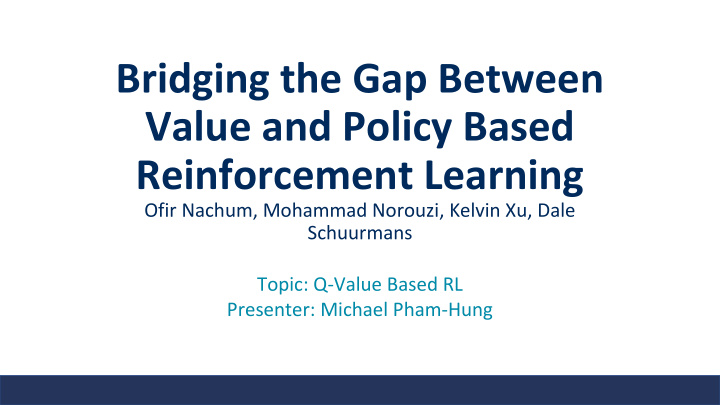



Bridging the Gap Between Value and Policy Based Reinforcement Learning Ofir Nachum, Mohammad Norouzi, Kelvin Xu, Dale Schuurmans Topic: Q-Value Based RL Presenter: Michael Pham-Hung
Motivation
Motivation i.e. Q-Learning Value Based RL + Data efficient + Learn from any trajectory
Motivation i.e. Q-Learning i.e. REINFORCE Value Based RL Policy Based RL + Data efficient + Stable deep function approximators + Learn from any trajectory
Motivation i.e. Q-Learning i.e. REINFORCE Value Based RL Policy Based RL + Data efficient + Stable deep function approximators + Learn from any trajectory ?????
Motivation i.e. Q-Learning i.e. REINFORCE Value Based RL Policy Based RL + Data efficient + Stable deep function approximators + Learn from any trajectory Profit.
Contributions Problem : Combining the advantages of on-policy and off-policy learning.
Contributions Problem : Combining the advantages of on-policy and off-policy learning. Why is this problem important?: - Model-free RL with deep function approximators seems like a good idea.
Contributions Problem : Combining the advantages of on-policy and off-policy learning. Why is this problem important?: - Model-free RL with deep function approximators seems like a good idea. Why is this problem hard?: - Value-based learning is not always stable with deep function approximators.
Contributions Problem : Combining the advantages of on-policy and off-policy learning. Why is this problem important?: - Model-free RL with deep function approximators seems like a good idea. Why is this problem hard?: - Value-based learning is not always stable with deep function approximators. Limitations of prior work: - Prior work remain potentially unstable and are not generalizable.
Contributions Problem : Combining the advantages of on-policy and off-policy learning. Why is this problem important?: - Model-free RL with deep function approximators seems like a good idea. Why is this problem hard?: - Value-based learning is not always stable with deep function approximators. Limitations of prior work: - Prior work remain potentially unstable and are not generalizable. Key Insight: Starting from first principles rather than performing naïve approaches can be more rewarding. Revealed: Results in flexible algorithm.
Outline Background - Q-Learning Formulation - Softmax Temporal Consistency - Consistency between optimal value and policy PCL Algorithm - Basic PCL - Unified PCL Results Limitations
Q-Learning Formulation
Q-Learning Formulation
Q-Learning Formulation One-hot distribution
Q-Learning Formulation
Q-Learning Formulation Hard-max Bellman temporal consistency!
Q-Learning Formulation Hard-max Bellman temporal consistency!
Soft-max Temporal Consistency -Augment the standard expected reward objective with a discounted entropy regularizer -This helps encourages exploration and helps prevent early convergence to sub-optimal policies
•
•
•
• Form of a Boltzmann distribution … No longer one hot distribution! Entropy term prefers the use of policies with more uncertainty.
•
• Note the log-sum-exp form!
Consistency Between Optimal Value & Policy • Normalization Factor
Consistency Between Optimal Value & Policy •
Consistency Between Optimal Value & Policy •
Consistency Between Optimal Value & Policy •
Consistency Between Optimal Value & Policy •
•
•
•
•
Algorithm - Path Consistency Learning (PCL) •
•
Algorithm - Path Consistency Learning (PCL) •
Algorithm - Unified PCL •
Algorithm - Unified PCL •
Experimental Results PCL can consistently match or beat the performance of A3C and double Q-learning. PCL and Unified PCL are easily implementable with expert trajectories. Expert trajectories can be prioritized in the replay buffer as well.
The results of PCL against A3C and DQN baselines. Each plot shows average reward across 5 random training runs (10 for Synthetic Tree) after choosing best hyperparameters. A signal standard deviation bar clipped at the min and max. The x-axis is number of training iterations. PCL exhibits comparable performance to A3C in some tasks, but clearly outperforms A3C on the more challenging tasks. Across all tasks, the performance of DQN is worse than PCL.
The results of PCL vs. Unified PCL. Overall found that using a single model for both values and policy is not detrimental to training. Although in some of the simpler tasks PCL has an edge over Unified PCL, on the more difficult tasks, Unified PCL performs better.
The results of PCL vs. PCL augmented with a small number of expert trajectories on the hardest algorithmic tasks. We find that incorporating expert trajectories greatly improves performance.
Discussion of results Using a single model for both values and policy is not detrimental to training The ability for PCL to incorporate expert trajectories without requiring adjustment or correction is a desirable property in real-world applications
Critique / Limitations / Open Issues -Only implemented on simple tasks - Addressed with Trust-PCL, which enables a continuous action space. -Requires small learning rates - Addressed with Trust-PCL, which uses Trust Regions -Proof was given for deterministic states but also works for stochastic states as well.
Contributions Problem : Combining the advantages of on-policy and off-policy learning. Why is this problem important?: - Model-free RL with deep functions approximators seems like a good idea. Why is this problem hard?: - Value-based learning is not always stable with deep function approximators. Limitations of prior work: - Prior work remain potentially unstable and are not generalizable. Key Insight: Starting from a theoretical approach rather than naïve approaches can be more fruitful. Revealed: Results in a quite flexible algorithm.
Exercise Questions •
Recommend
More recommend